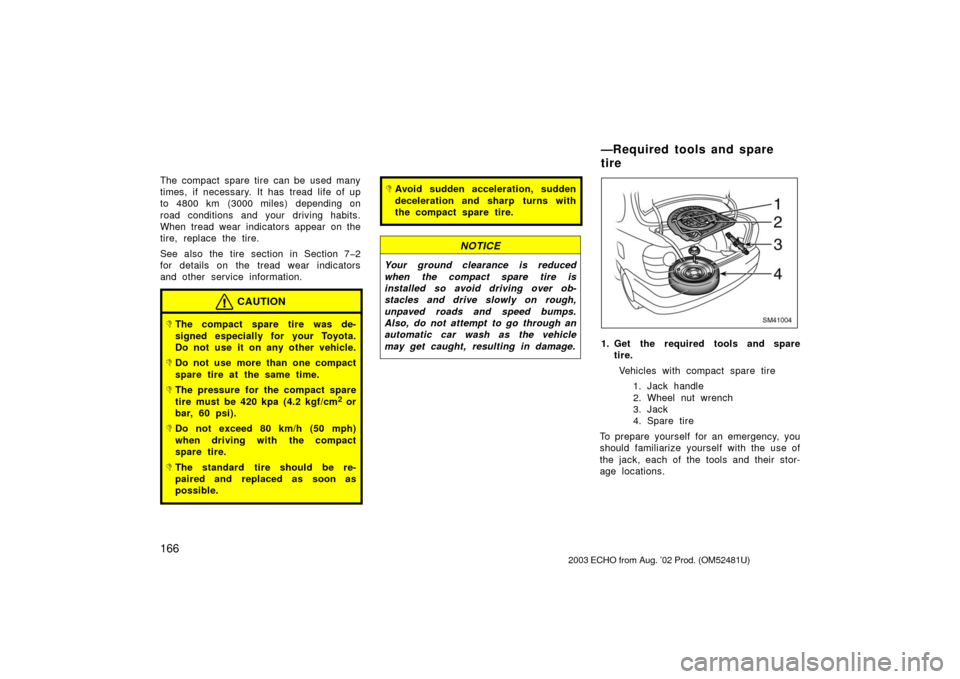Page 170 of 241

166
The compact spare tire can be used many
times, if necessary. It has tread life of up
to 4800 km (3000 miles) depending on
road conditions and your driving habits.
When tread wear indicators appear on the
tire, replace the tire.
See also the tire section in Section 7�2
for details on the tread wear indicators
and other service information.
CAUTION
�The compact spare tire was de-
signed especially for your Toyota.
Do not use it on any other vehicle.
�Do not use more than one compact
spare tire at the same time.
�The pressure for the compact spare
tire must be 420 kpa (4.2 kgf/cm2 or
bar, 60 psi).
�Do not exceed 80 km/h (50 mph)
when driving with the compact
spare tire.
�The standard tire should be re-
paired and replaced as soon as
possible.
�Avoid sudden acceleration, sudden
deceleration and sharp turns with
the compact spare tire.
NOTICE
Your ground clearance is reduced
when the compact spare tire is
installed so avoid driving over ob-
stacles and drive slowly on rough,
unpaved roads and speed bumps.
Also, do not attempt to go through an
automatic car wash as the vehicle
may get caught, resulting in damage.SM41004
1. Get the required tools and spare tire.
Vehicles with compact spare tire 1. Jack handle
2. Wheel nut wrench
3. Jack
4. Spare tire
To prepare yourself for an emergency, you
should fam iliarize yourself with the use of
the jack, each of the tools and their stor-
age locations.
2003 ECHO from Aug. ’02 Prod. (OM52481U)
—R eq u ired to o ls an d sp are
tire
Page 213 of 241

209
�
Be sure to reinstall the tire inflation
valve caps.
Without the valve caps,
dirt or moisture could get into the valve
core and cause air leakage. If the caps
have been lost, have new ones put on
as soon as possible.
Checking and replacing tires
70040D01
Tread wear indicator
CHECKING YOUR TIRES
Check the tires tread for the tread wear
indicators. If the indicators show, re-
place the tires.
The tires on your Toyota have built�in
tread wear indicators to help you know
when the tires need replacement. When
the tread depth wears to 1.6 mm (0.06
in.) or less, the indicators will appear. If
you can see the indicators in two or more
adjacent grooves, the tire should be re-
placed. The lower the tread, the higher
the risk of skidding.
The effectiveness of snow tires is lost
if the tread wears down below 4 mm
(0.16 in.). If you have tire damage such as cuts,
splits, cracks deep enough to expose
the fabric, or bulges indicating internal
damage, the tire should be replaced.
If a tire often goes flat or cannot be prop-
erly repaired due to the size or location
of a cut or other damage, it should be
replaced. If you are not sure, consult with
your Toyota dealer.
If an air loss occurs while driving, do not
continue driving with a deflated tire. Driv-
ing even a short distance can damage a
tire beyond repair.
Any tires which are over 6 years old
must be checked by a qualified techni-
cian even if damage is not obvious.
Tires deteriorate with age even if they
have never or seldom been used.
This applies also to the spare tire and
tires stored for future use.
REPLACING YOUR TIRES
When replacing a tire, use a tire of the
same size and construction, and the
same or greater load capacity as the
originally installed tires.
2003
ECHO from Aug. ’02 Prod. (OM52481U)
Page 216 of 241

212
SH72005
Vehicle equipped with Sports Fender and
Rocker Panel for 185/60R15 tires
TIRE CHAIN SELECTION
Use the tire chains of correct size and
type.
For vehicle equipped with Sports Fender
and Rocker Panel for 185/60R15 tires, use
the following type chains.mm (in.)
A Diameter of side chain 3 (0.12)
B Width of side chain 10 (0.39)
C Length of side chain 30 (1.18)
D Diameter of cross chain: 4 (0.16)
E width of cross chain 14 (0.55)
F Length of cross chain 25 (0.98) For vehicle equipped without Sports Fend-
er and Rocker Panel for 175/65R14 and
185/60R15 tires, use SAE Class “S” type
radial tire chains except radial cable
chains or V�bar type chains.
Regulations regarding the use of tire
chains vary according to location or
type of road, so always check them
before installing chains.
CHAIN INSTALLATION
Install the chains on the front tires as
tightly as possible. Do not use tire
chains on the rear tires. Retighten
chains after driving 0.5—1.0 km
(1/4—1/2 mile).
When installing chains on your tires, care-
fully follow the instructions of the chain
manufacturer.
If wheel covers are used, they will be
scratched by the chain band, so remove
the covers before putting on the chains.
CAUTION
�Do not exceed 50 km/h (30 mph) or
the chain manufacturer ’s recom-
mended speed limit, whichever is
lower.
�Drive carefully avoiding bumps,
holes, and sharp turns, which may
cause the vehicle to bounce.
�Avoid sharp turns or locked�wheel
braking, as use of chains may ad-
versely affect vehicle handling.
�When driving with chains installed,
be sure to drive carefully. Slow
down before entering the curves to
avoid losing control of the vehicle.
Otherwise an accident may occurs.
NOTICE
Do not attempt to use a tire chain on
the compact spare tire, as it may re-
sult in damage to the vehicle as well
as the tire.
2003
ECHO from Aug. ’02 Prod. (OM52481U)